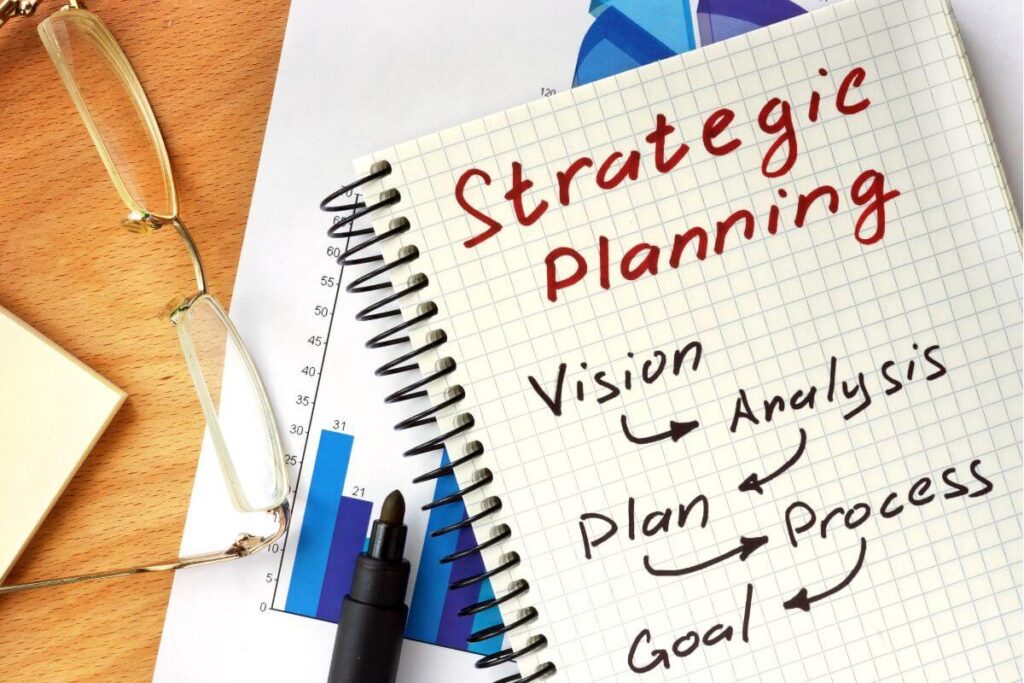In today’s rapidly evolving market, standing out from the crowd isn’t just a goal but the key to thriving in a space brimming with innovation and creativity. Fortunately, strategic planning is the secret sauce for navigating the competitive tides of the product development industry.
Think of strategic planning as your trusty map and compass, allowing your product to become a market leader from a mere idea. Additionally, it can unlock the strategies that will elevate your products even further.
In this article, we will guide you on the path to flourish in the dynamic and ever-evolving world of product development.
What is strategic planning?
Strategic planning in product development is like drafting a master blueprint. It is about setting clear visions for where you want your product to go and plotting a course to get there.

Besides, this process distinguishes your product with a unique identity, aligning it with the needs and desires of your market. It is not merely about beating the competition; it’s about understanding your customers so well that your product becomes the obvious choice for them.
Unlike routine business planning, strategic planning focuses on long-term goals and strategies rather than short-term operational tactics. Moreover, it encompasses vision, mission, objectives, strategies, and action plans, all designed to provide a clear path to success and competitive superiority.
How about strategic plan management?
Strategic plan management plays a critical role in the broader context of strategic planning. It ensures that the strategic goals and visions outlined in the planning phase are effectively translated into actionable steps and realized through meticulous execution and continuous oversight.

Besides, it bridges the gap between high-level strategic planning and the day-to-day operations of an organization, particularly in the dynamic field of product development. By meticulously operationalizing the strategic objectives, it ensures that the abstract goals set during the planning phase are translated into concrete, actionable plans.
A key aspect of strategic plan management is the efficient allocation of resources. As a result, it ensures that financial, human, and technological assets are optimally deployed to areas of highest strategic importance.
Moreover, this targeted allocation supports the seamless execution of initiatives that are pivotal for achieving the set goals, thereby enhancing the organization’s efficiency and effectiveness.
The role of strategic plan management also extends to monitoring performance and facilitating adaptation. It enables organizations to track their progress toward strategic goals by setting up key performance indicators (KPIs) and monitoring mechanisms.
Benefits of refined strategic planning
Strategic planning offers numerous benefits to organizations. A refined planning can enhance the ability to navigate the complexities of the modern business environment and secure a competitive edge
1. Gives everyone a clear path
Think of refined strategic planning as the ultimate roadmap. It makes sure everyone in the organization knows where they’re going and how they fit into the big picture. This clarity helps teams work together more smoothly and keeps everyone rowing in the same direction.
2. Smarter decisions
With a solid strategic plan, making tough choices gets easier. It’s like having a cheat sheet that helps you decide where to spend your time and money. This leads to smarter, more strategic decisions that can propel the organization forward.
3. Stays nimble and quick
A good strategic plan is not just about sticking to a set path; it’s about being ready to dodge and weave when obstacles appear. This agility means the organization can quickly grab new opportunities or sidestep potential setbacks, staying ahead in the game.
4. No wasted effort
By focusing resources on what really matters, a refined strategic plan ensures that every dollar and every hour spent is aimed at something that will help the organization succeed. It’s about doing more of what works and less of what doesn’t, making the most of what you have.
5. Builds stronger connections
A clear strategic plan lets everyone know where the organization is headed, building trust and support among employees, customers, and investors. When people understand the vision, they’re more likely to get behind it and contribute to its success.
6. Prepare for tomorrow
The future is full of surprises, but with strategic planning, an organization can be ready for them. By looking ahead and predicting changes, companies can position themselves to take advantage of future trends and avoid being left behind.
7. Edge over the competition
Ultimately, all these benefits add up to a significant competitive advantage. Organizations with well-thought-out strategic plans can outmaneuver competitors, meet customer needs more effectively, and operate more efficiently, securing their place at the top of the market.
Steps in strategic planning you need to know
It is a comprehensive process that guides organizations in setting their direction and priorities for the future. Here is an overview of the key steps involved in strategic planning:
- Define vision and mission: Establish the organization’s aspirational future (vision) and its core purpose (mission).
- Conduct a situational analysis: Use tools like SWOT to evaluate internal strengths and weaknesses, and external opportunities and threats.
- Set objectives and goals: Identify broad outcomes (objectives) and specific, quantifiable targets (goals) based on the vision, mission, and analysis.
- Develop strategies: Outline the roadmap and approaches for achieving the set objectives and goals.
- Create action plans: Break down strategies into detailed steps, including actions, timelines, responsibilities, and resources.
- Implement the plan: Execute the action plans, mobilizing resources and ensuring team alignment.
- Monitor and evaluate: Track progress using metrics and KPIs, and assess the effectiveness of strategies and actions.
- Review and revise: Periodically update the strategic plan to reflect new insights, changes in the market, or internal developments.
For more details about these steps, you can learn how to develop a strategic plan.
Final thoughts
Strategic planning isn’t just about charting a course. It is about setting your sights on the horizon, where opportunities abound for those brave enough to pursue them.
Additionally, this process transforms the daunting task of standing out in a crowded market into an exciting quest for creating products that resonate deeply with consumers.
By embracing strategic planning, you are not just navigating the present. Instead, you are crafting a legacy of products that leave a mark on the industry and in the hearts of your customers.
You can give AssetIT a try if your organization is working on the Jira platform. It is an effective tool to help you monitor and manage all available assets and resources and allocate them to each project accordingly




